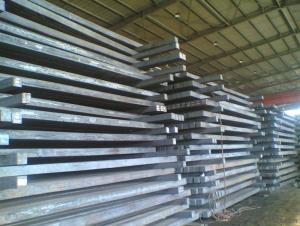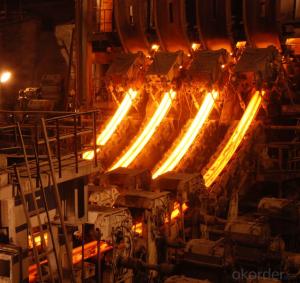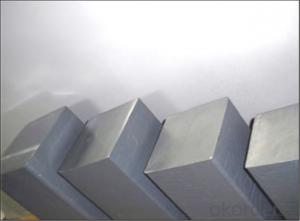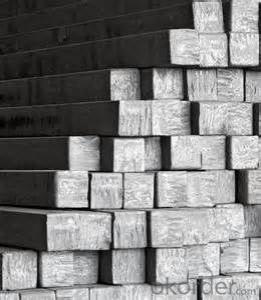Square Steel Billet Q235 3SP Grade Prime Quality 12#
- Loading Port:
- Tianjin
- Payment Terms:
- TT OR LC
- Min Order Qty:
- 2000 m.t
- Supply Capability:
- 50000 m.t/month
OKorder Service Pledge
OKorder Financial Service
You Might Also Like
Description of Square Steel Billet Q235 3SP Grade Prime Quality 12#
M. S. Billets are used for rolling of TMT Re-Bars of Fe415 and Fe500 Grade and various other structural steel products.
CRS Billets are used for rolling of CRS TMT Re-Bars.
Special Alloy Billets are used for rolling of any special grade TMT Re-Bars like Earthquake resistant TMT Re-Bars and for special grade structural steel products.
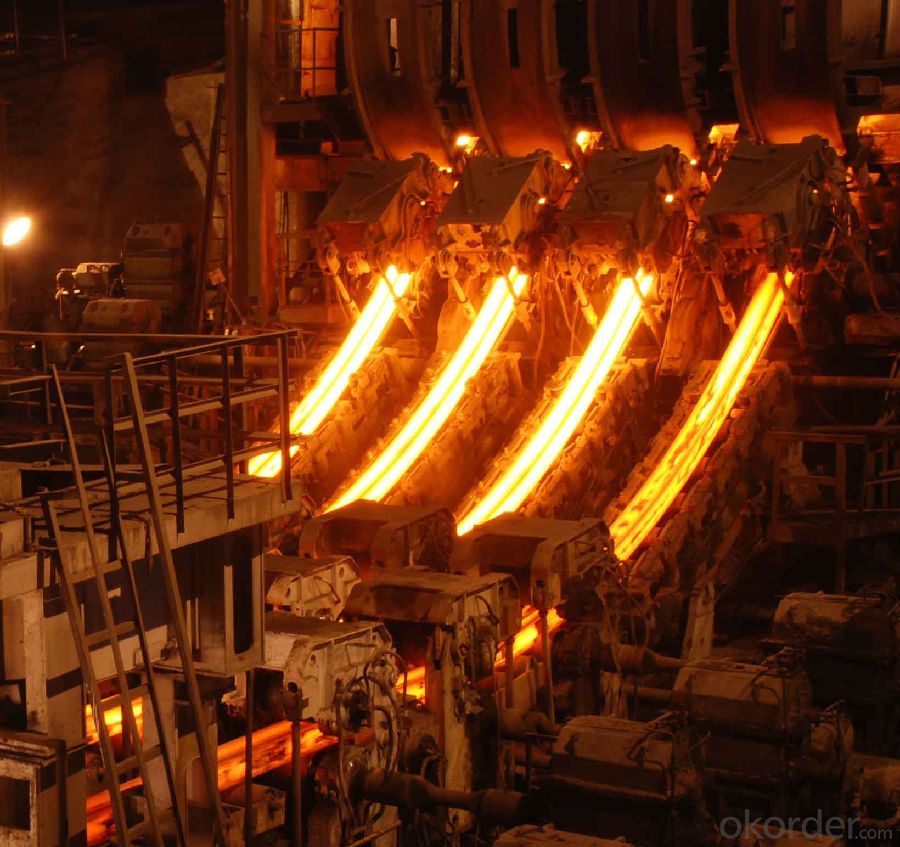
Main Feature Square Steel Billet Q235 3SP Grade Prime Quality 12#
Raw elements(C,Fe,Ni,Mn,Cr,Cu.)---Smelted ingots by AOD finery---hot rolled into black suface---pickling in acid liquid---cold drawn----polished by automatically machine--- cutting into pieces---checking quanlity
Applications of Square Steel Billet Q235 3SP Grade Prime Quality 12#
Widely Used in the areas such as Stainless Steel Fasteners, Chains, Kitchen and Sanitary wares, Furniture handles, Handrails, Electroplating and Electrolyzing pendants, Foods, Electron, Petroleum, Construction and Decoration, etc. Products have a high strength after cold-working. Electronic products parts, Medical appliance, Springs, Bus Inside and Outside packaging and building, Street Lamp Posts, etc. Decoration materials and Outdoor Publicity Billboard. Used for the products which have the Anti-Stress Corrosion requirement. Electron Products, Table-wares, Bolts, Nuts, Screen Meshes, Cumbustors and so on.
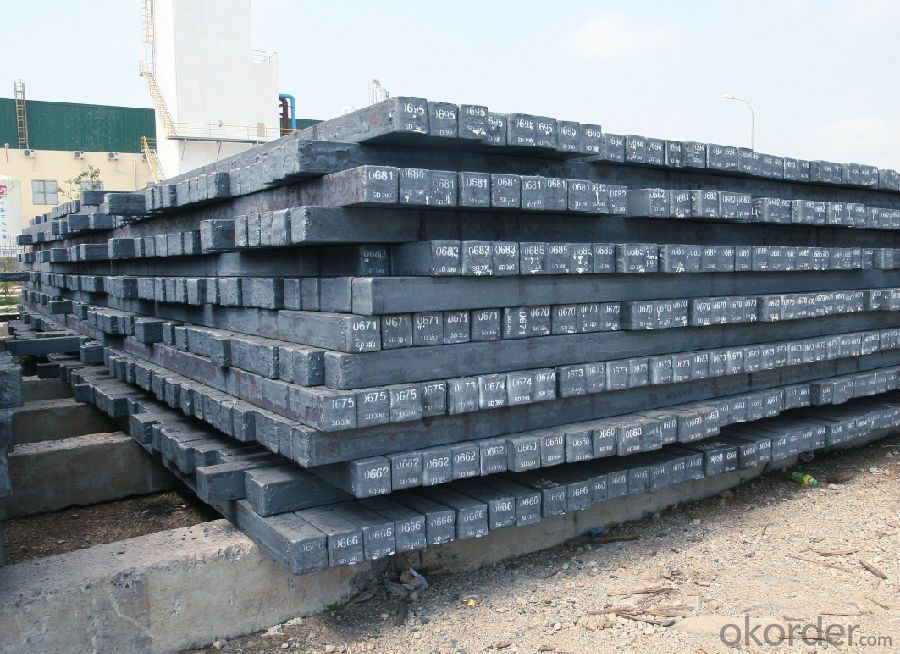
Specifications of Square Steel Billet Q235 3SP Grade Prime Quality 12#
| Standard | C(%) | Mn(%) | S(%) | P(%) | Si(%) |
| Q195 | ≤0.12 | ≤0.50 | ≤0.040 | ≤0.035 | ≤0.30 |
| Q235 | ≤0.20 | ≤1.40 | ≤0.045 | ≤0.045 | ≤0.35 |
| Q275 | ≤0.22 | ≤1.50 | ≤0.045 | ≤0.045 | ≤0.35 |
| 20MnSi | 0.17-0.25 | 1.2-1.6 | ≤ 0.050 | ≤ 0.050 | 0.40-0.80 |
| 3SP | 0.14-0.22 | 0.40-0.85 | ≤ 0.050 | ≤ 0.040 | 0.05-0.15 |
| 5SP | 0.28-0.37 | 0.50-1.00 | ≤ 0.050 | ≤ 0.040 | 0.15-0.30 |
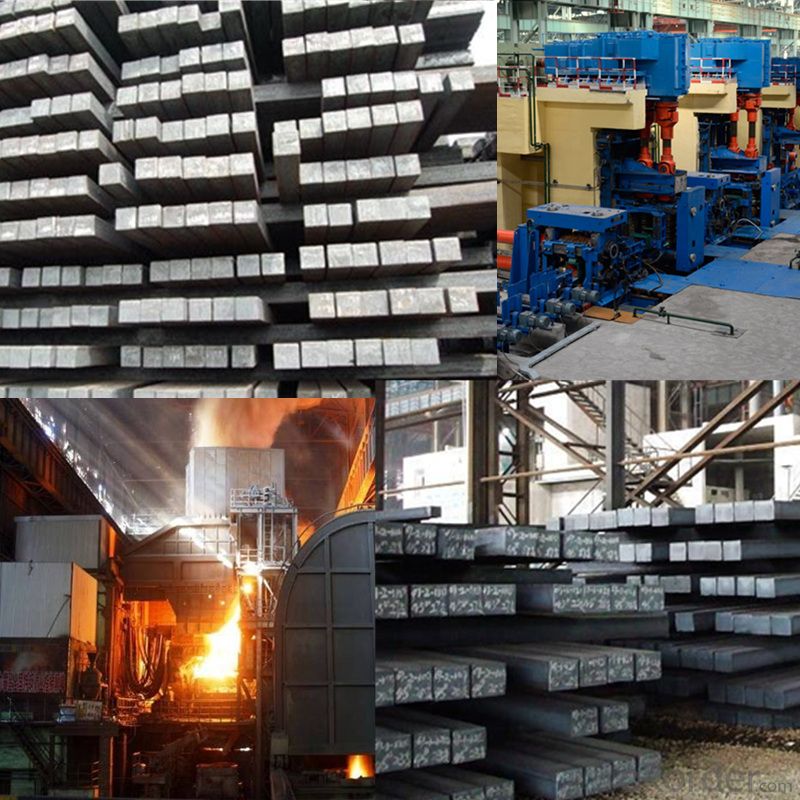
FAQ of Square Steel Billet Q235 3SP Grade Prime Quality 12#
We have organized several common questions for our clients,may help you sincerely:
1. How Can I Visit There?
Our company is located in Tianjin City, China, near Beijing. You can fly to Tianjin Airport Directly. All our clients, from home or aboard, are warmly welcome to visit us!
2. How Can I Get Some Sample?
We are honored to offer you sample.
3. Why choose CNBM?
Our delivery time about 15-20days for standard sizes, if you have other requirements like hardness, quanity and width ,it is about 20-40days. But don't worry we also try our best for the delivery time ,because time longer and our cost is higher.
- Q:Are steel billets used in the production of electrical appliances?
- No, steel billets are not typically used in the production of electrical appliances. Electrical appliances are usually made from materials like plastic, aluminum, or stainless steel.
- Q:How are steel billets used in the production of electrical transmission towers?
- Steel billets are an essential component in the production of electrical transmission towers. These billets are essentially semi-finished steel products that are cast into a specific shape and size. In the case of electrical transmission towers, steel billets are used as raw material to manufacture the tower structures. The process begins with the selection of high-quality steel billets, which are carefully inspected for their chemical composition and physical properties. Once the billets meet the required specifications, they are heated and passed through a series of rolling mills to form the desired shape and size of the tower sections. The steel billets are first heated to a specific temperature to make them malleable. This heating process helps in reducing the internal stresses and enhancing the ductility of the steel. The heated billets are then passed through multiple rolling stands, where they are shaped into various sections such as angles, channels, and I-beams. These sections are further cut into appropriate lengths and welded together to form the framework of the transmission tower. The steel billets provide the necessary strength and structural integrity to withstand the weight of the tower, as well as the environmental loads such as wind and ice. Moreover, the use of steel billets ensures that the transmission towers have excellent corrosion resistance, as steel is known for its durability and longevity. This is crucial in maintaining the reliability and safety of the power transmission infrastructure. Overall, steel billets play a vital role in the production of electrical transmission towers by providing the raw material required for manufacturing the tower structures. Their strength, durability, and corrosion resistance make them an ideal choice for constructing towers that can support the transmission lines and ensure the efficient and reliable distribution of electricity.
- Q:What are the main challenges in the production of steel billets?
- The production of steel billets, which are semi-finished products that serve as the raw material for various steel products, involves several challenges. One of the main challenges is ensuring consistent and high-quality raw materials. Steel billets are typically produced from scrap metal or iron ore, and obtaining a reliable supply of these materials can be challenging due to fluctuations in availability and cost. Another challenge is achieving the desired chemical composition and mechanical properties of the steel billets. The production process involves various steps such as melting, refining, and casting, and each step must be carefully controlled to achieve the desired outcome. Maintaining precise control over the temperature, alloying elements, and impurities during these processes is crucial to ensure the final product meets the required specifications. The choice of casting method is also important in the production of steel billets. Casting can be done through continuous casting or ingot casting, and each method has its own advantages and disadvantages. Continuous casting is more commonly used as it offers higher productivity and better control over the final product's dimensions and surface quality. However, continuous casting requires sophisticated equipment and expertise to maintain a stable and continuous process. The cooling and solidification process after casting is also a critical challenge in steel billet production. Proper cooling is essential to avoid defects such as cracks, segregations, or uneven microstructures. The cooling rate needs to be carefully controlled to achieve the desired microstructure and mechanical properties of the billets. Furthermore, the handling and storage of steel billets can present challenges. Billets are often transported and stored in large quantities, and maintaining their quality and preventing damage during these processes is important. Proper handling equipment, storage conditions, and logistics management are necessary to minimize any potential damage or loss. Lastly, environmental considerations are increasingly important in steel billet production. The process can generate significant amounts of emissions, waste, and energy consumption. Meeting environmental regulations and implementing sustainable practices, such as recycling scrap metal or reducing energy consumption, can pose challenges but are crucial for the long-term viability of the industry. In summary, the main challenges in the production of steel billets include ensuring consistent and high-quality raw materials, achieving the desired chemical composition and mechanical properties, choosing the appropriate casting method, controlling the cooling and solidification process, handling and storage, and addressing environmental concerns. Overcoming these challenges requires a combination of advanced technology, skilled workforce, and efficient management practices in the steel production industry.
- Q:What are the potential applications of steel billets in the automotive aftermarket?
- Steel billets have numerous potential applications in the automotive aftermarket. They can be used to manufacture various critical components such as engine parts, suspension systems, and drivetrain components. Additionally, steel billets can be utilized to fabricate customized performance parts, enhancing the overall performance and durability of vehicles. Their versatility and strength make them a valuable resource for meeting the diverse needs of the automotive aftermarket industry.
- Q:What are the challenges faced in the distribution and supply chain of steel billets?
- There are several challenges faced in the distribution and supply chain of steel billets. Firstly, one major challenge is the transportation of steel billets. Steel billets are heavy and bulky, requiring specialized equipment and infrastructure for their transportation. This can lead to higher logistics costs and difficulties in finding suitable transport options, especially for international shipments. Secondly, the storage and inventory management of steel billets can be challenging. Steel billets require proper storage facilities to prevent corrosion and damage. Additionally, managing inventory levels and ensuring timely deliveries can be complex, as steel billets are often sourced from multiple suppliers and delivered to various locations. Thirdly, quality control is a significant challenge in the distribution and supply chain of steel billets. Ensuring consistent quality throughout the supply chain requires strict adherence to quality standards and effective quality control measures. This includes regular inspections, testing, and certification processes to guarantee the integrity and suitability of the steel billets. Another challenge is the fluctuating demand and market conditions. The steel industry is highly cyclical, with demand and prices subject to economic fluctuations and global market trends. This poses challenges in terms of forecasting demand, managing production capacity, and optimizing inventory levels to meet customer requirements while minimizing costs. Furthermore, global trade regulations and customs procedures can create challenges in the distribution and supply chain of steel billets. Compliance with various import and export regulations, including trade restrictions and tariffs, can impact the flow of steel billets across different countries, leading to delays and additional costs. Lastly, ensuring sustainable and responsible sourcing practices is becoming increasingly important in the steel industry. Meeting environmental and social standards, such as responsible sourcing of raw materials and reducing carbon emissions, can be challenging for steel billet manufacturers and distributors. This requires implementing sustainable practices throughout the supply chain, which may involve additional costs and complexities. In conclusion, the distribution and supply chain of steel billets face challenges related to transportation, storage, quality control, demand fluctuations, trade regulations, and sustainable sourcing. Overcoming these challenges requires effective planning, strong partnerships, and the implementation of efficient processes to ensure a smooth and reliable supply of steel billets to customers.
- Q:What is the role of steel billets in the manufacturing of construction excavators?
- Steel billets play a crucial role in the manufacturing of construction excavators as they serve as the raw material for various components of the excavator. These billets are used to forge and shape the structural elements, such as the boom, arm, and bucket, which require high strength and durability to withstand the heavy-duty operations of an excavator. Additionally, steel billets are also used to fabricate the undercarriage and other critical parts, ensuring the overall stability and performance of the construction excavator.
- Q:Difference between medium frequency continuous casting billet and electric furnace continuous casting billet
- 3, intermediate frequency furnace can not decarburization, gas and inclusion content in steel such as H element content is high, the steel has high strength, hydrogen embrittlement characteristics, lower elongation, plastic failure, and electric arc furnace on the contrary.4, even smelting high carbon steel, alloy tool steel or casting, because of the above process defects, the quality of steel is still better than the electric steel, but sometimes the demand is not high, you can use
- Q:What are the main factors affecting the corrosion resistance of alloy steel billets?
- The corrosion resistance of alloy steel billets can be influenced by several key factors. Firstly, the resistance to corrosion is determined by the composition of the alloy steel. Steels with a higher percentage of elements like chromium, nickel, and molybdenum tend to have improved corrosion resistance compared to steels with lower alloy content. Secondly, the application of protective surface coatings or finishes can greatly enhance the corrosion resistance of alloy steel billets. Coatings such as zinc or epoxy act as a barrier between the metal surface and the corrosive environment, preventing direct contact with corrosive agents. Furthermore, the corrosion resistance of alloy steel billets can be affected by the manufacturing process. Proper heat treatment and quenching processes can improve the microstructure of the alloy, resulting in a more corrosion-resistant material. The environment in which the alloy steel billets are exposed is also a crucial factor. Elements like temperature, humidity, pH levels, and the presence of corrosive substances can all impact corrosion resistance. For instance, high temperatures or acidic environments can accelerate corrosion, while dry or neutral conditions may have minimal impact. Lastly, the design and maintenance of structures or equipment made from alloy steel billets can influence their corrosion resistance. Considerations like avoiding moisture accumulation in sharp corners or crevices can help minimize the risk of corrosion. Regular inspection, cleaning, and maintenance can also prevent corrosion by promptly addressing any issues. To summarize, the key factors affecting the corrosion resistance of alloy steel billets include the steel's composition, the presence of protective coatings, the manufacturing process, the environmental conditions, and the design and maintenance practices. By considering these factors, manufacturers and users can ensure optimal corrosion resistance in various applications of alloy steel billets.
- Q:How are steel billets formed into other shapes?
- Steel billets are formed into other shapes through a process called hot rolling or cold rolling. Hot rolling involves heating the steel billet to a high temperature and then passing it through a series of rollers to apply pressure and shape it into the desired form. This process is typically used for larger and more complex shapes such as beams, channels, and angles. On the other hand, cold rolling is performed at room temperature, and it involves passing the steel billet through a series of rollers to gradually reduce its thickness and shape it into sheets, strips, or coils. Cold rolling is commonly used for producing thinner and more precise shapes like plates, foils, and bars. In addition to rolling, steel billets can also be formed into other shapes through processes such as forging, extrusion, and casting. Forging involves applying pressure to the heated billet using a die or hammer to shape it into the desired form. Extrusion involves pushing the heated billet through a die to produce long and continuous shapes like pipes or tubes. Casting involves pouring molten steel into a mold and allowing it to solidify into the desired shape. Overall, the formation of steel billets into other shapes requires various manufacturing processes such as hot rolling, cold rolling, forging, extrusion, or casting, depending on the desired shape and properties of the final product. These processes ensure that steel billets can be transformed into a wide range of shapes for different applications in industries such as construction, automotive, aerospace, and manufacturing.
- Q:What are the different types of steel alloys used for manufacturing steel billets?
- There are several different types of steel alloys that are commonly used for manufacturing steel billets. These alloys are specifically designed to offer various properties and characteristics to meet the requirements of different applications. One commonly used steel alloy for manufacturing steel billets is carbon steel. Carbon steel is an alloy that primarily consists of iron and carbon. It is known for its strength and durability, making it suitable for a wide range of applications such as construction, automotive, and machinery. Stainless steel is another type of steel alloy that is frequently used for manufacturing steel billets. It is composed of iron, chromium, and other elements such as nickel and molybdenum. Stainless steel is highly resistant to corrosion, making it ideal for applications where exposure to moisture or harsh environments is a concern, such as marine equipment, medical instruments, and kitchen utensils. Another type of steel alloy used for manufacturing steel billets is alloy steel. Alloy steel is made by adding various alloying elements such as manganese, nickel, chromium, and vanadium to the base iron. This enhances the strength, hardness, and wear resistance of the steel, making it suitable for applications that require high durability and toughness, such as aerospace components, automotive parts, and industrial machinery. Tool steel is yet another type of steel alloy commonly used for manufacturing steel billets. It is a high-carbon alloy that contains additional elements such as tungsten, molybdenum, and vanadium. Tool steel is known for its exceptional hardness, heat resistance, and wear resistance, which makes it ideal for applications that involve cutting, drilling, and shaping, such as cutting tools, drills, and molds. In summary, the different types of steel alloys used for manufacturing steel billets include carbon steel, stainless steel, alloy steel, and tool steel. Each of these alloys offers specific properties and characteristics that make them suitable for different applications across various industries.
1. Manufacturer Overview |
|
|---|---|
| Location | |
| Year Established | |
| Annual Output Value | |
| Main Markets | |
| Company Certifications | |
2. Manufacturer Certificates |
|
|---|---|
| a) Certification Name | |
| Range | |
| Reference | |
| Validity Period | |
3. Manufacturer Capability |
|
|---|---|
| a)Trade Capacity | |
| Nearest Port | |
| Export Percentage | |
| No.of Employees in Trade Department | |
| Language Spoken: | |
| b)Factory Information | |
| Factory Size: | |
| No. of Production Lines | |
| Contract Manufacturing | |
| Product Price Range | |
Send your message to us
Square Steel Billet Q235 3SP Grade Prime Quality 12#
- Loading Port:
- Tianjin
- Payment Terms:
- TT OR LC
- Min Order Qty:
- 2000 m.t
- Supply Capability:
- 50000 m.t/month
OKorder Service Pledge
OKorder Financial Service
Similar products
New products
Hot products
Related keywords

